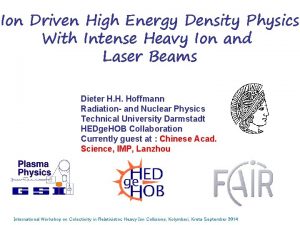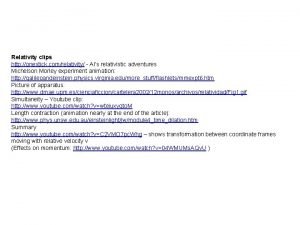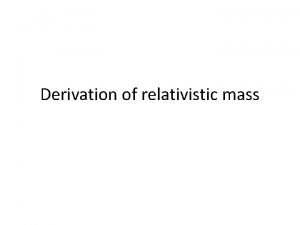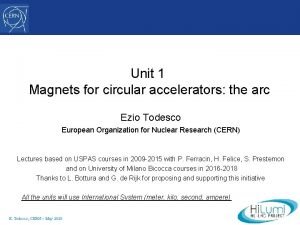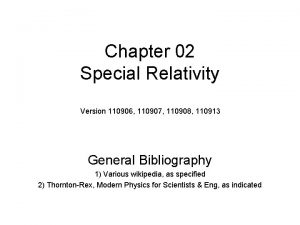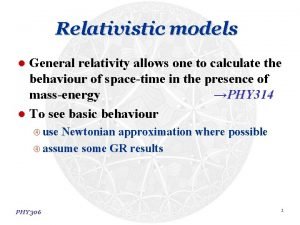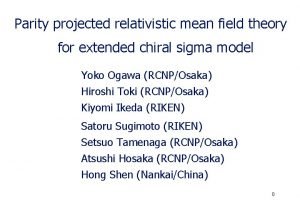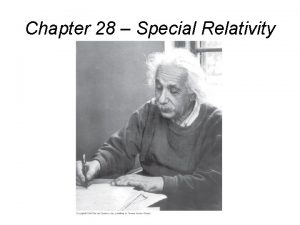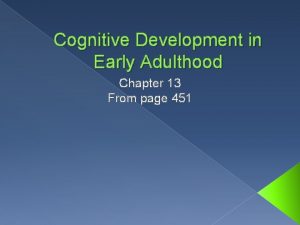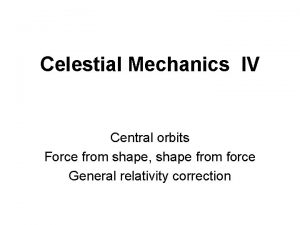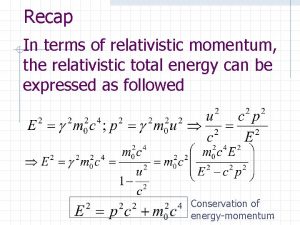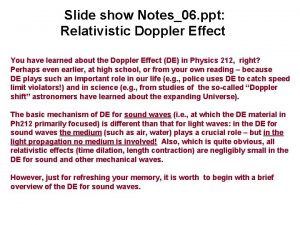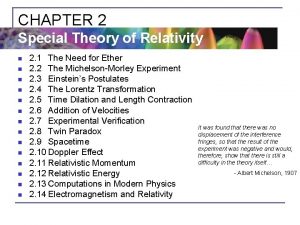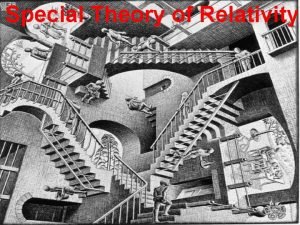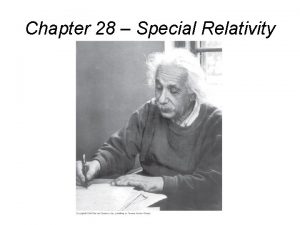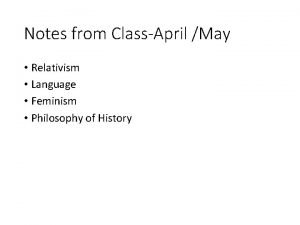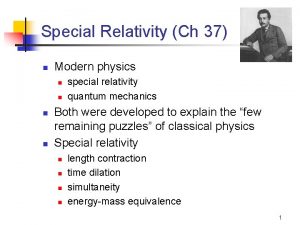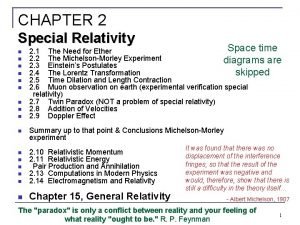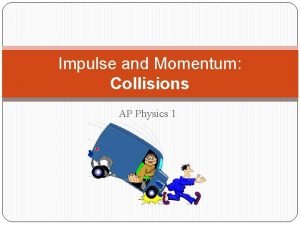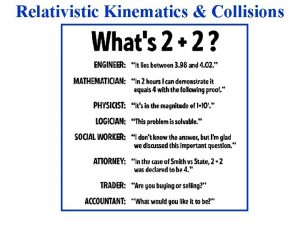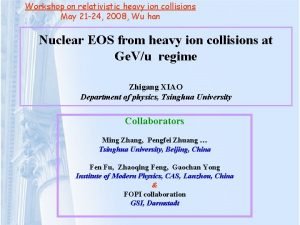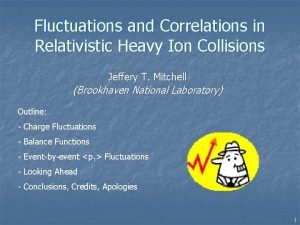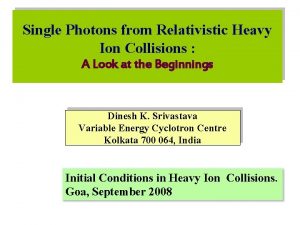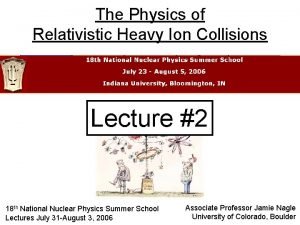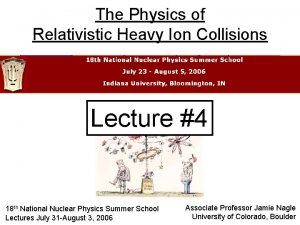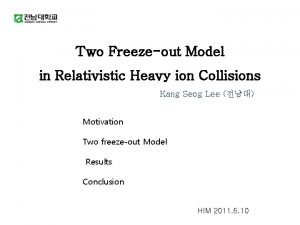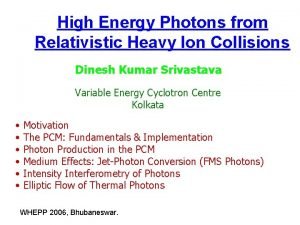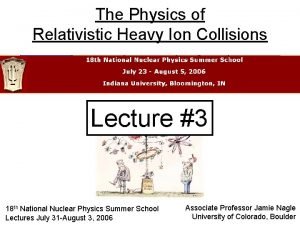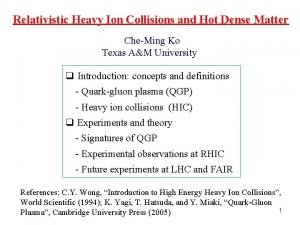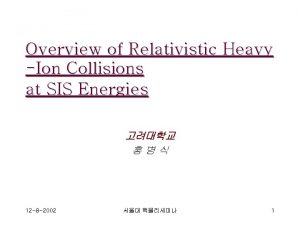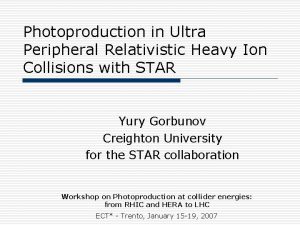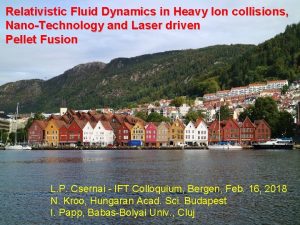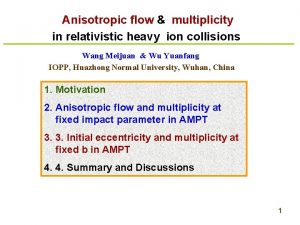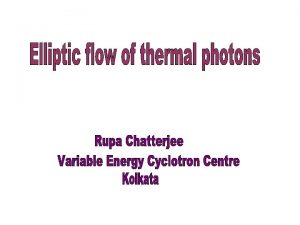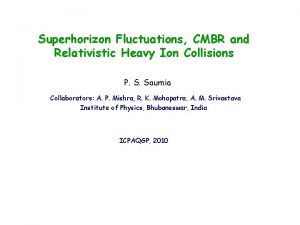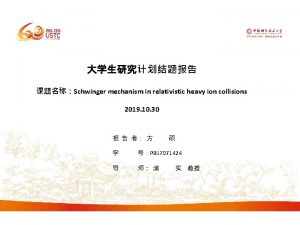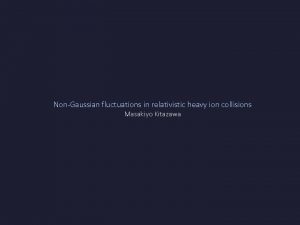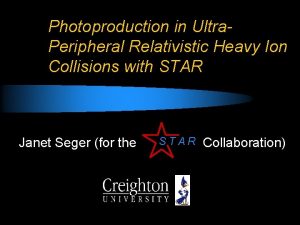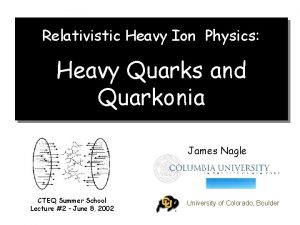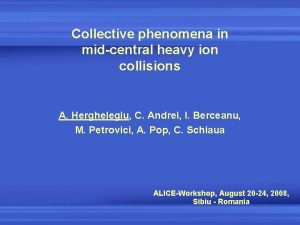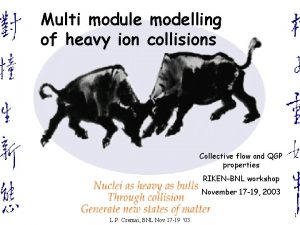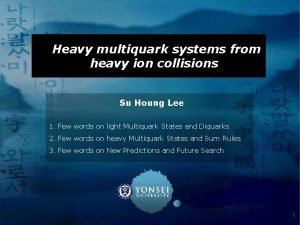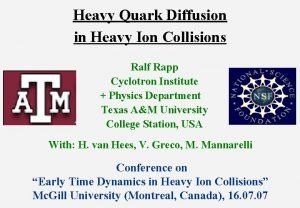Collective Expansion in Relativistic Heavy Ion Collisions Talk200407


























- Slides: 26

Collective Expansion in Relativistic Heavy Ion Collisions //Talk/2004/07 USTC 04/NXU_USTC_8 July 04// -- Search for the partonic EOS at RHIC Nu Xu Lawrence Berkeley National Laboratory Many Thanks to Organizers Prof. Weiqing Chao Jinghua Fu, Yugang Ma, Enke Wang J. Castillo, X. Dong, H. Huang, H. G. Ritter, K. Schweda, P. Sorensen, A. Tai, Z. Xu Nu Xu CCAST, Beijing, China, 2004 1

Outline //Talk/2004/07 USTC 04/NXU_USTC_8 July 04// Ø Introduction Ø Bulk properties - ∂PQCD - hadron spectra - elliptic flow v 2 Ø Summary and Outlook Nu Xu CCAST, Beijing, China, 2004 2

//Talk/2004/07 USTC 04/NXU_USTC_8 July 04// Phase diagram of strongly interacting matter CERN-SPS, RHIC, LHC: high temperature, low baryon density AGS, GSI (SIS 200): Nu Xu moderate temperature, high baryon density CCAST, Beijing, China, 2004 3

High-energy Nuclear Collisions //Talk/2004/07 USTC 04/NXU_USTC_8 July 04// Initial Condition - initial scatterings - baryon transfer - ET production - parton dof Q 2 jets J/y, D TC Tch f System Evolves - parton interaction - parton/hadron expansion Bulk Freeze-out - hadron dof - interactions stop D, p Nu Xu partonic scatterings? early thermalization? elliptic flow v 2 L p, K, K* time d, HBT CCAST, Beijing, China, 2004 radial flow b. T Tfo 4

Physics Goals at RHIC //Talk/2004/07 USTC 04/NXU_USTC_8 July 04// Identify and study the properties of matter with partonic degrees of freedom. Penetrating probes Bulk probes - direct photons, leptons - “jets” and heavy flavor - spectra, v 1, v 2 … - partonic collectivity - fluctuations = Hydrodynamic Local jets - observed high p. T hadrons (at RHIC, p. T(min) > 3 Ge. V/c) Collectivity collectivity - collective motion of observed hadrons, not necessarily reached Flow Thermalization thermalization among them. Nu Xu CCAST, Beijing, China, 2004 5

Equation of State //Talk/2004/07 USTC 04/NXU_USTC_8 July 04// With given degrees of freedom, the EOS - the system response to the changes of thermal condition - is fixed by its p and T or . Nu Xu Energy density Ge. V/fm 3 Equation of state: - EOS I : relativistic ideal gas: p = /3 - EOS H: resonance gas: p ~ /6 - EOS Q: Maxwell construction: Tcrit= 165 Me. V, B 1/4 = 0. 23 Ge. V lat=1. 15 Ge. V/fm 3 P. Kolb et al. , Phys. Rev. C 62, 054909 (2000). CCAST, Beijing, China, 2004 6

Collision Geometry //Talk/2004/07 USTC 04/NXU_USTC_8 July 04// z Au + Au s. NN = 200 Ge. V Non-central Collisions be am x Number of participants: number of incoming nucleons in the overlap region Number of binary collisions: number of inelastic nucleon-nucleon collisions Charged particle multiplicity Reaction plane: x-z plane Nu Xu collision centrality CCAST, Beijing, China, 2004 7

Charged Hadron Density //Talk/2004/07 USTC 04/NXU_USTC_8 July 04// 19. 6 Ge. V 130 Ge. V 200 Ge. V Charged hadron pseudo-rapidity PHOBOS Collaboration 1) High number of Nch indicates initial high density; 2) Mid-y, Nch Npart nuclear collisions are not incoherent; 3) Saturation model works Initial high parton density at RHIC PRL 85, 3100 (00); 91, 052303 (03); 88, 22302(02); 91, 052303 (03) Nu Xu CCAST, Beijing, China, 2004 8

Suppression and Correlation //Talk/2004/07 USTC 04/NXU_USTC_8 July 04// In central Au+Au collisions: hadrons are suppressed and back-to-back ‘jets’ are disappeared. Different from p+p and d+Au collisions. Energy density at RHIC: > 5 Ge. V/fm 3 ~ 30 0 Parton energy loss: Bjorken (“Jet quenching”) Gyulassy & Wang … Nu Xu CCAST, Beijing, China, 2004 1982 1992 9

Energy Loss and Equilibrium //Talk/2004/07 USTC 04/NXU_USTC_8 July 04// Leading hadrons Medium In Au +Au collision at RHIC: - Suppression at the intermediate p. T region - energy loss - The energy loss leads to progressive equilibrium in Au+Au collisions STAR: nucl-ex/0404010 Nu Xu CCAST, Beijing, China, 2004 10

Energy Loss //Talk/2004/07 USTC 04/NXU_USTC_8 July 04// (1) Measured spectra show evidence of suppression up to p. T ~ 6 Ge. V/c; (2) Jet-like behavior observed in correlations: - hard scatterings in AA collisions - disappearance of back-to-back correlations “Partonic” Energy loss process leads to progressive equilibrium in the medium Next step: fix the partonic Equation of State, bulk properties Nu Xu CCAST, Beijing, China, 2004 11

Pressure, Flow, … //Talk/2004/07 USTC 04/NXU_USTC_8 July 04// tds = d. U + pd. V s– entropy; p – pressure; U – energy; V – volume t = k. BT, thermal energy per dof In high-energy nuclear collisions, interaction among constituents and density distribution will lead to: pressure gradient collective flow number of degrees of freedom (dof) Equation of State (EOS) No thermalization is needed – pressure gradient only depends on the density gradient and interactions. Space-time-momentum correlations! Nu Xu CCAST, Beijing, China, 2004 12

Transverse Flow Observables //Talk/2004/07 USTC 04/NXU_USTC_8 July 04// As a function of particle mass: • • • Directed flow (v 1) – early Elliptic flow (v 2) – early Radial flow – integrated over whole evolution Note on collectivity: 1) Effect of collectivity is accumulative – final effect is the 2) sum of all processes. 2) Thermalization is not needed to develop collectivity - pressure gradient depends on density gradient and interactions. Nu Xu CCAST, Beijing, China, 2004 13

Hadron Spectra from RHIC mid-rapidity, p+p and Au+Au collisions at 200 Ge. V //Talk/2004/07 USTC 04/NXU_USTC_8 July 04// 5% centrality (ss) 10 -20% 20 -40% 40 -60% (usd) (sss) 60 -80% Results from BRAHMS, PHENIX, and STAR experiments Nu Xu CCAST, Beijing, China, 2004 14

Compare with Model Results //Talk/2004/07 USTC 04/NXU_USTC_8 July 04// Model results fit to , K, p spectra well, but over predicted <p. T> for multi-strange hadrons - Do they freeze-out earlier? Phys. Rev. C 69 034909 (04); Phys. Rev. Lett. 92, 112301(04); 92, 182301(04); P. Kolb et al. , Phys. Rev. C 67 044903(03) Nu Xu CCAST, Beijing, China, 2004 15

Thermal model fit //Talk/2004/07 USTC 04/NXU_USTC_8 July 04// Source is assumed to be: – Local thermal equilibrated – Boosted radially boosted E. Schnedermann, J. Sollfrank, and U. Heinz, Phys. Rev. C 48, 2462(1993) random Nu Xu CCAST, Beijing, China, 2004 16

Thermal fits: Tfo vs. < T > //Talk/2004/07 USTC 04/NXU_USTC_8 July 04// 200 Ge. V Au + Au collisions 1) , K, and p change smoothly from peripheral to central collisions. 2) At the most central collisions, < T> reaches 0. 6 c. 3) Multi-strange particles , are found at higher Tfo (T~Tch) and lower < T> Sensitive to early partonic stage! How about v 2? Chemical Freeze-out: inelastic interactions stop Kinetic Freeze-out: elastic interactions stop Nu Xu CCAST, Beijing, China, 2004 STAR: NPA 715, 458 c(03); PRL 92, 112301(04); 92, 182301(04). 17

Anisotropy Parameter v 2 //Talk/2004/07 USTC 04/NXU_USTC_8 July 04// coordinate-space-anisotropy momentum-space-anisotropy y py x px Initial/final conditions, Eo. S, degrees of freedom Nu Xu CCAST, Beijing, China, 2004 18

v 2 at Low p. T //Talk/2004/07 USTC 04/NXU_USTC_8 July 04// P. Huovinen, private communications, 2004 - At low p. T, hydrodynamic model fits well for minimum bias events indicating early thermalization in Au+Au collisions at RHIC! - More theoretical work needed to understand details: v 2 centrality dependence; consistency between v 2 and spectra… Nu Xu CCAST, Beijing, China, 2004 19

v 2 at All p. T //Talk/2004/07 USTC 04/NXU_USTC_8 July 04// PHENIX: PRL 91, 182301(03) STAR: PRL 92, 052302(04) Models: Greco et al, PRC 68, 034904(03) v 2, the spectra of multistrange hadrons, and the scaling of the number of constituent quarks Partonic collectivity has been attained at RHIC! Deconfinement, model dependently, has been attained at RHIC! Next question is thermalization of light flavors at RHIC: - v 2 of charm hadrons - J/ distributions !! Nu Xu CCAST, Beijing, China, 2004 20

Nuclear Modification Factor //Talk/2004/07 USTC 04/NXU_USTC_8 July 04// 1) Baryon vs. meson effect! 2) Hadronization via coalescence - (K 0, ): PRL 92, 052303(04); NPA 715, 466 c(03); - Greco et al, PRC 68, 034904(03); PRL 90, 202102(03) - R. Fries et al, PRC 68, 044902(03); ), Hwa, nucl-th/0406072 Nu Xu 3) Parton thermalization (model) CCAST, Beijing, China, 2004 21

Bulk Freeze-out Systematics //Talk/2004/07 USTC 04/NXU_USTC_8 July 04// The additional increase in T is likely due to partonic pressure at RHIC. 1) v 2 self-quenching, hydrodynamic model works at low p. T 2) Multi-strange hadron freeze-out earlier, Tfo~ Tch 3) Multi-strang hadron show strong v 2 Nu Xu CCAST, Beijing, China, 2004 22

Partonic Collectivity at RHIC //Talk/2004/07 USTC 04/NXU_USTC_8 July 04// 1) Copiously produced hadrons freeze-out: Tfo = 100 Me. V, T = 0. 6 (c) > T(SPS) 2)* Multi-strange hadrons freeze-out: Tfo = 160 -170 Me. V (~ Tch), T = 0. 4 (c) 3)** Multi-strange v 2: Multi-strange hadrons and flow! 4)*** Constituent Quark scaling: Seems to work for v 2 and RAA (RCP) Partonic (u, d, s) collectivity at RHIC! Nu Xu CCAST, Beijing, China, 2004 23

Summary & Outlook //Talk/2004/07 USTC 04/NXU_USTC_8 July 04// (1) Charged multiplicity - high initial density (2) Parton energy loss - QCD at work (3) Collectivity - pressure gradient ∂PQCD Deconfinement and Partonic collectivity Open issues - partonic (u, d, s) thermalization - heavy flavor v 2 and spectra - di-lepton and thermal photon spectra Nu Xu CCAST, Beijing, China, 2004 24

//Talk/2004/07 USTC 04/NXU_USTC_8 July 04// LHC Phase diagram of strongly interacting matter RHIC GSI CERN-SPS, RHIC, LHC: high temperature, low baryon density AGS, GSI (SIS 200): Nu Xu moderate temperature, high baryon density CCAST, Beijing, China, 2004 25

Future readings: //Talk/2004/07 USTC 04/NXU_USTC_8 July 04// - http: //qm 2004. lbl. gov/ - Quark Matter conference proceedings 2002 Nucl. Phys. A 715, 1 c(2003). - Quark Matter conference proceedings 2001 Nucl. Phys. A 698, 1 c(2002). - “Introduction to High Energy Heavy Ion Collisions’’ - By C. Y. Wong (Oak Ridge), . 1995. Singapore, Singapore: World Scientific (1994) 516 p. - “Introduction to Relativistic Heavy Ion Collisions’’ - By L. P. Csernai (Bergen U. ), . 1994. Chichester, UK: Wiley (1994) 310 p. - Recent discussions on the QGP discovery http: //www. bnl. gov/riken/May 14 -152004 workshop. htm Nu Xu CCAST, Beijing, China, 2004 26
 Top heavy bottom heavy asymptotes
Top heavy bottom heavy asymptotes Heavy ion
Heavy ion Ion dipolo
Ion dipolo Ion dipolo
Ion dipolo Dipolos instantaneos
Dipolos instantaneos London dispersion
London dispersion Bertrand postulate
Bertrand postulate Physical development in adulthood
Physical development in adulthood Relativistic mass formula
Relativistic mass formula Relativistic circular motion
Relativistic circular motion Relativistic kinetic energy
Relativistic kinetic energy Relativistic acceleration calculator
Relativistic acceleration calculator Relativistic mean field theory
Relativistic mean field theory Relativistic kinetic energy
Relativistic kinetic energy Cognitive-affective complexity
Cognitive-affective complexity Relativistic thinking example
Relativistic thinking example Relativistic equations of binet
Relativistic equations of binet Relativistic momentum
Relativistic momentum Relativistic doppler effect ppt
Relativistic doppler effect ppt Relativistic velocity
Relativistic velocity Length contraction
Length contraction A physical education chapter 28
A physical education chapter 28 Relativistic thinking example
Relativistic thinking example Relativistic momentum
Relativistic momentum Rest energy of a proton
Rest energy of a proton Difference between elastic and inelastic collision
Difference between elastic and inelastic collision Ap physics collisions
Ap physics collisions

